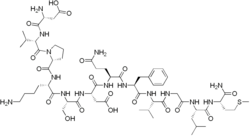 | |
| Names | |
|---|---|
| Other names L-alpha-aspartyl-L-valyl-L-prolyl-L-lysyl-L-seryl-L-alpha-aspartyl-L-glutaminyl-L-phenylalanyl-L-valyl-glycyl-L-leucyl-L-methioninamide | |
| Identifiers | |
3D model (JSmol) | |
| ChEMBL | |
| ChemSpider | |
| MeSH | Kassinin |
PubChem CID | |
| UNII | |
CompTox Dashboard (EPA) | |
| |
| |
| Properties | |
| C59H95N15O18S | |
| Molar mass | 1334.54 |
Except where otherwise noted, data are given for materials in their standard state (at 25 °C [77 °F], 100 kPa). | |
Kassinin is a peptide derived from the Kassina frog. [1] It belongs to tachykinin family of neuropeptides. It is secreted as a defense response, and is involved in neuropeptide signalling. [2]
Contents
The amino acid sequence is H-Asp-Val-Pro-Lys-Ser-Asp-Gln-Phe-Val-Gly-Leu-Met-NH2 (DVPKSDQFVGLM-NH2).